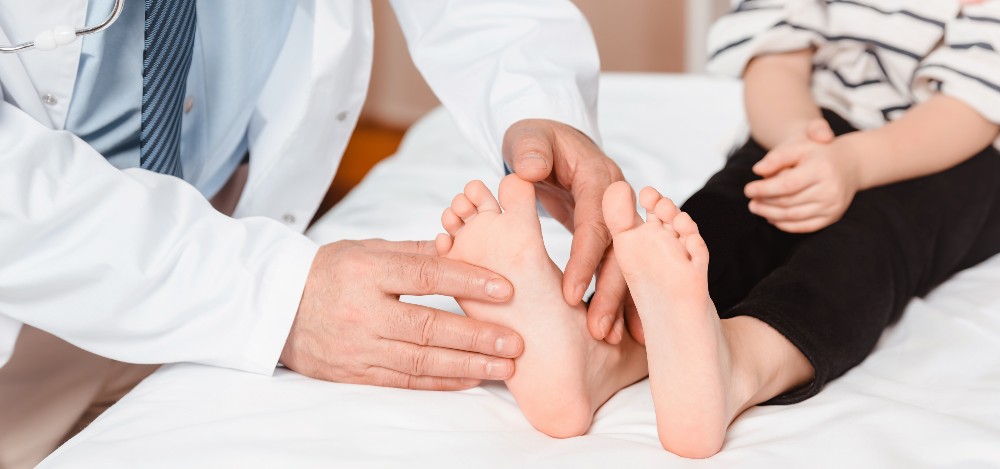Sever's Disease
Contrary to what its name suggests, Sever’s disease is not actually a disease. Instead, it’s a condition that can develop in active children and adolescents whose bones are still growing. Read on for more information about the causes and symptoms of Sever’s, how it is diagnosed, and how to treat it.
Understanding Children’s Heel Pain and Sever’s Disease
Sometimes referred to as calcaneal apophysitis, Sever’s disease is a type of overuse injury that occurs as the result of repetitive stress on the growth plate of the back of the heel. Constant strain can cause the growth plate to become inflamed and painful, making it difficult for an active child or adolescent to walk or run. Sever’s disease is most common among children between the ages of 8 and 14 since this is when they are in the middle of their growing years, and boys are more likely to develop Sever’s than girls.
The Causes of Sever’s Disease
Sever’s disease is often caused by overuse during physical activities such as running and jumping. Children and adolescents who participate in regular sports and other strenuous activities are most at risk for developing this condition. Other factors that can contribute to Sever’s disease include wearing inappropriate shoes, having flat feet or high arches, or suffering from a tight Achilles tendon.
Symptoms of Sever’s Disease
The most common symptom of Sever’s disease is pain in the heel or around the Achilles tendon. The pain is usually worse after physical activity and can sometimes be relieved by stretching or applying cold packs to the affected areas.
In some cases, other symptoms such as swelling or limping may be present. If your child is complaining of heel pain or exhibiting any of the above-mentioned symptoms, it is important to have them evaluated by our podiatrist.

Diagnosis and Treatment of Sever’s Disease
Sever’s disease can usually be diagnosed based on a physical examination and medical history. If the diagnosis is uncertain, your doctor may order imaging tests such as an X-ray or MRI to confirm the diagnosis. If confirmed, the condition can be treated with one or more of the following options.
Rest From Strenuous Physical Activities or Sports
Treatment for Sever’s disease largely includes resting from activities that cause pain and discomfort. This can mean taking a break from sports or other strenuous physical activities for a few weeks, or until the pain subsides. Many doctors recommend limiting activity until the pain is gone to prevent further injury.
Proper Footwear for Physical Activity
Footwear is the starting point for many children with Sever’s disease. Properly fitting shoes with good arch support and cushioning can help reduce the stress placed on the heel. Look for pairs designed specifically for sports and activities your child participates in.
Stretching and Strengthening Exercises
Our doctor may also recommend a series of stretching and strengthening exercises that can be done to help reduce pain and swelling. These exercises should be done regularly to help keep the area flexible and strong.
Ice and Heat Therapy
Ice packs and heat therapy can be used to help reduce the pain and inflammation associated with Sever’s disease. The application of ice should be done for 15 minutes at a time, and it should not be applied directly to the skin. Heat therapy should also be used in moderation and should never exceed 20 minutes at a time.
Custom Orthotics
In some cases, your child may require custom orthotics to help support the growth plate and reduce pressure on the heel. This involves the use of a molded insert that is designed to fit the exact shape and size of your child’s foot. Custom orthotics can be very effective in helping to reduce pain and inflammation caused by Sever’s disease.
MLS Laser Therapy
Our laser therapy helps with all types of foot and ankle pain. The MLS Laser system uses two therapeutic lasers, which help to trigger your child’s natural immune system to the source of the pain. This can reduce swelling, ease pain, and increase blood flow, all without any medications or aftercare needed. Talk with our doctor to learn more about if this treatment will be right for your child’s heel pain.

Does Sever’s Disease Ever Go Away?
While it can be debilitating in some cases, the good news is that Sever’s disease is a temporary problem that children outgrow with age. With proper treatment, including rest and exercises, the pain will gradually subside and your child can return to their usual activities without fear of recurrence. In most cases, Sever’s disease goes away completely within a year or two.
Let Us Help Treat Your Child’s Heel Pain
Kansas Foot Clinic specializes in the diagnosis and treatment of Sever’s disease. Our doctor and experienced team can provide the guidance and treatment your child needs to get back on their feet. Contact us today for more information or to schedule an appointment.
© Community Foot Clinic of McPherson. All Rights Reserved.
Privacy Policy | Terms & Conditions
Web Design by CP Solutions
Marketed by VMD Services
